belt VOLKSWAGEN GOLF MK6 2012 Owners Manual
[x] Cancel search | Manufacturer: VOLKSWAGEN, Model Year: 2012, Model line: GOLF MK6, Model: VOLKSWAGEN GOLF MK6 2012Pages: 516, PDF Size: 105.12 MB
Page 5 of 516
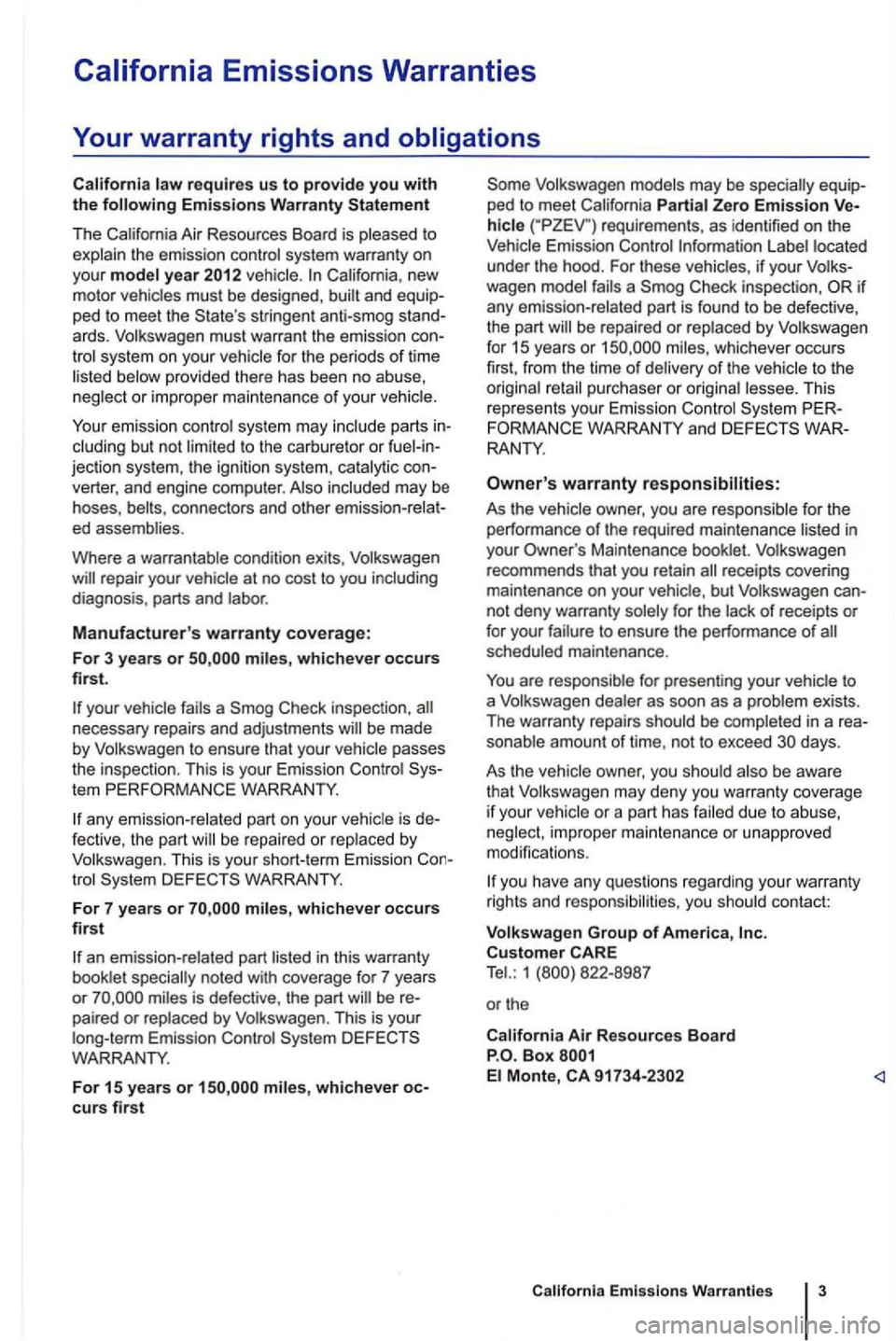
requires us to provide you with the
Cali fornia, new motor vehicles mu st be designed, built and ped to meet the
trol system on your vehicle for the periods of time
listed below provided there has been no abuse ,
ne glect or improper maint en anc e of yo
ur vehic le.
Your emissio n control system may includ e parts
jection syste m , th e ignit ion system, catalytic verte r, and engine computer. Al so in cluded may be
hoses , belts, con nectors and other
repair your vehicle at no cos t to you including
diagnosis , p arts and labor .
Manufacturer's warranty coverage:
For 3 years or miles, whichever occurs first.
necessary repairs and adjustments be made
b y Volkswagen to ensure that your passes
the inspection . Thi s is your Em ission Control
any emission -re lated part on your vehicle is be repai red or re placed by
Volkswagen . Th is is you r short-t erm Emission trol WARRA NTY.
For 7 years or miles, whichever occurs first
paired or rep laced by Vo lkswagen. This is your long-t erm Emi ssion Contro l
miles, whichever
req uire ments , a s identified on the
Vehic le Em ission Control Information Labe l located
under the hood. For these vehicles ,
if your wagen model fai ls a
WARRANTY and RANTY.
warranty responsibilities:
As the vehicle owner, you are res ponsible for th e
performance of th e req uired maintenan ce listed in your rece ipts covering
maintenance on your vehic le, but Volkswage n not deny warranty fo r the lack of receipts or
for your failure to ensure the performance of scheduled ma intenan ce.
sonable amount of time , n ot to exceed days.
As the vehicle owner, you shou ld also
be aware
th at Volkswage n may deny you warranty cove rage
if your vehi cle or a part has due to abuse,
negle ct, imp rope r maintena nce or unapproved
modificat io ns.
yo u have any question s regardi ng your warran ty
righ ts and responsibilities, you should cont act:
Volkswagen Group of America,
Tel. : 1
Box
Page 114 of 516
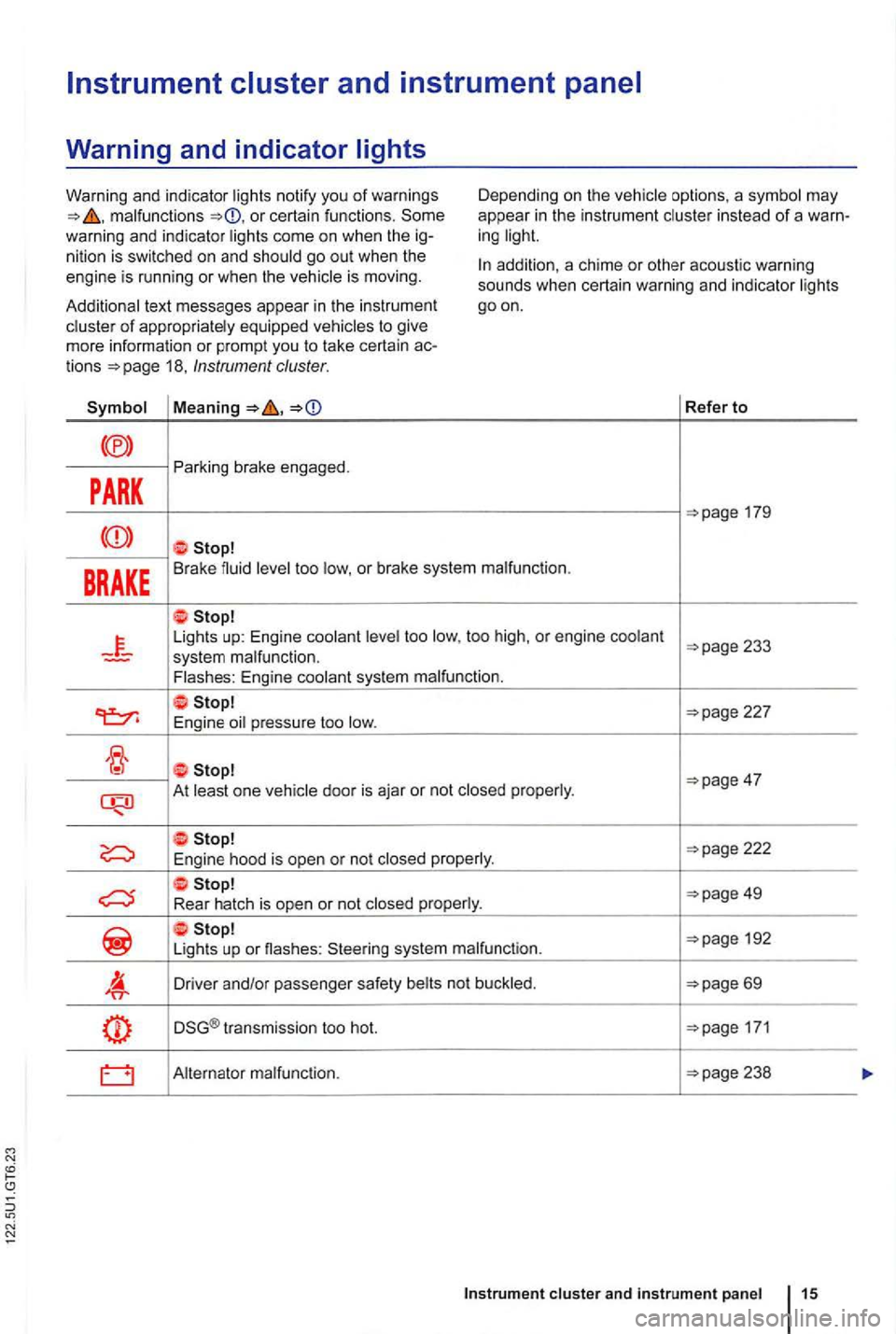
malfunctions or certain functions . Some
warning and indicator ligh ts come on when the ig
nition is swi tched on and shou ld go out when the
engine is running or when the vehicle is moving. D
epending on the vehicle options, a symbol may
appea r
in the instrum en t cluster in stead of a warn
ing light.
Additional text messages appear in th e instrumen t
cluster
of appropriately equipped vehicles to give
mo re information or prompt you to take certain actions 18, Instrument cluster.
addition, a chime or other acoustic warning
sounds when certain warning and indicator lights
goon.
Refer to
PARK
Parking brake engaged.
BRAKE Brake fluid level too low, o r brake system malfunction .
Lights up: Engine coolant level too low, too high , or engine coolant
227
E ngine oil pressure too low.
At least one vehicle door is aja r or not closed properly .
192
Li gh ts up or nashes : Steering system malfunction.
Driver and/or passenger safety belts not buckled .
DSG® transmission too hot. 171
Alternator malfunction.
cluster and instrument panel 15
Page 130 of 516
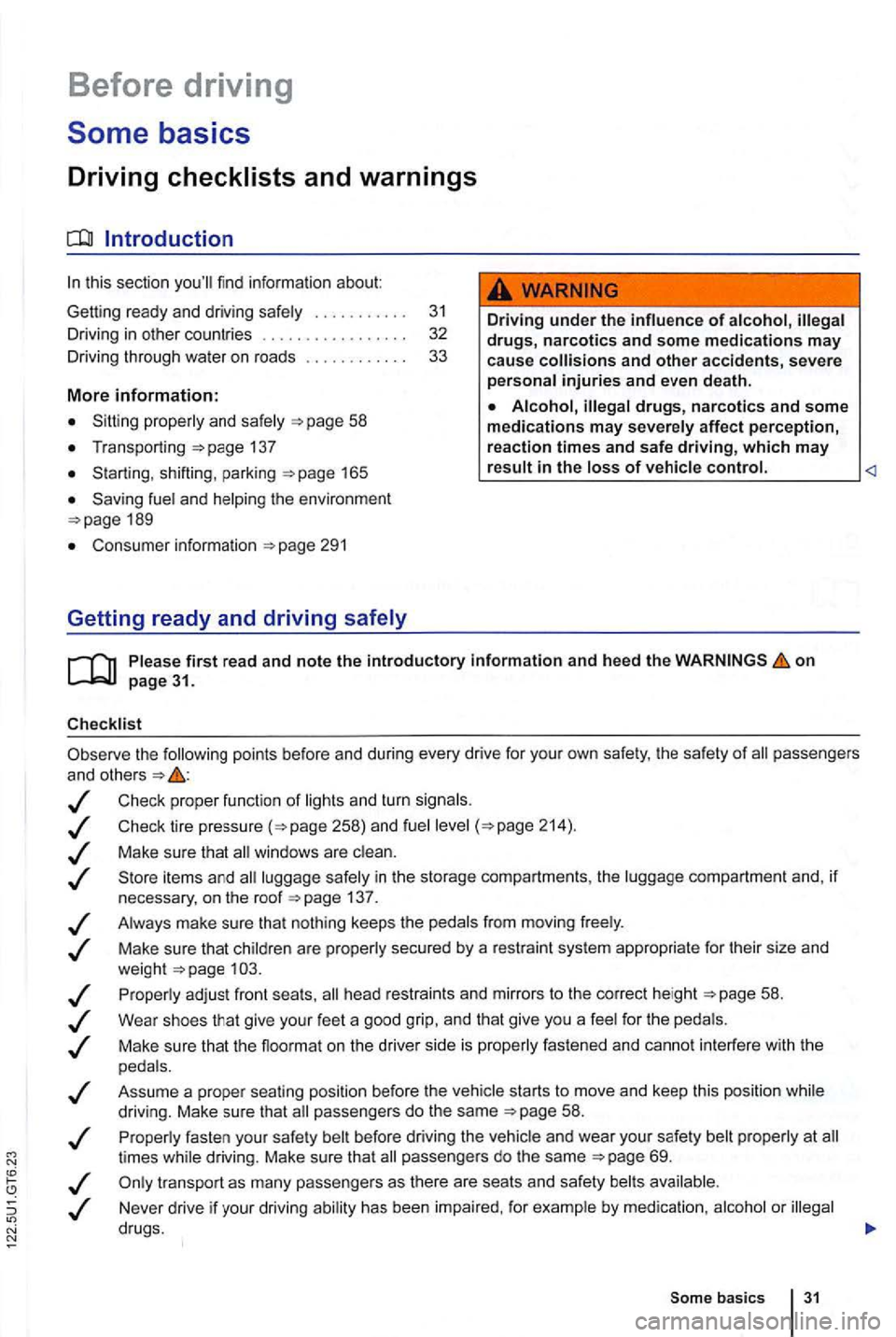
Before driving
this sectio n yo u'll find infor ma tion about
Gett ing ready and driving safely . . . . . . . . . . . 3 1
Driving in other countr ies . . . . . . . . . . . . . . . 32
Driving through
water on ro ads . . . . . . . . . . 33
More information:
S tarting , shift ing, pa rking 1 65
189
Consumer information
Driving under the influence of alcohol,
on
the following points be fore and during every drive for you r own safe ty, the safety of passengers
and other s
Check proper functio n of lights and turn signa ls .
Check tire pressu re
258) and fuel 214) .
Make su re that win dows are .
137 .
Always make sure tha t nothing keeps th e pedals from moving freely .
Make sure that children are properly sec
ured by a rest raint sys tem appropriate for their size and
weigh t .
Proper ly ad just front seats , head restraints and mirrors to the correct height
give your feet a good grip, and that give you a feel for the peda ls .
M ake sure that the floormat on the drive r side is properly fastened and canno t interfere with the
peda ls .
Assume a prope r sea ti
ng posi tion before the vehicle starts to move and keep this positio n whil e
driving. Make sure that passe ngers do the same 58 .
P roper ly fasten your safe ty bel t before
driving the vehic le and wear you r safety belt properly at times while driving. Make sure that passe ngers do the same
or
Som e basics 31
Page 157 of 516
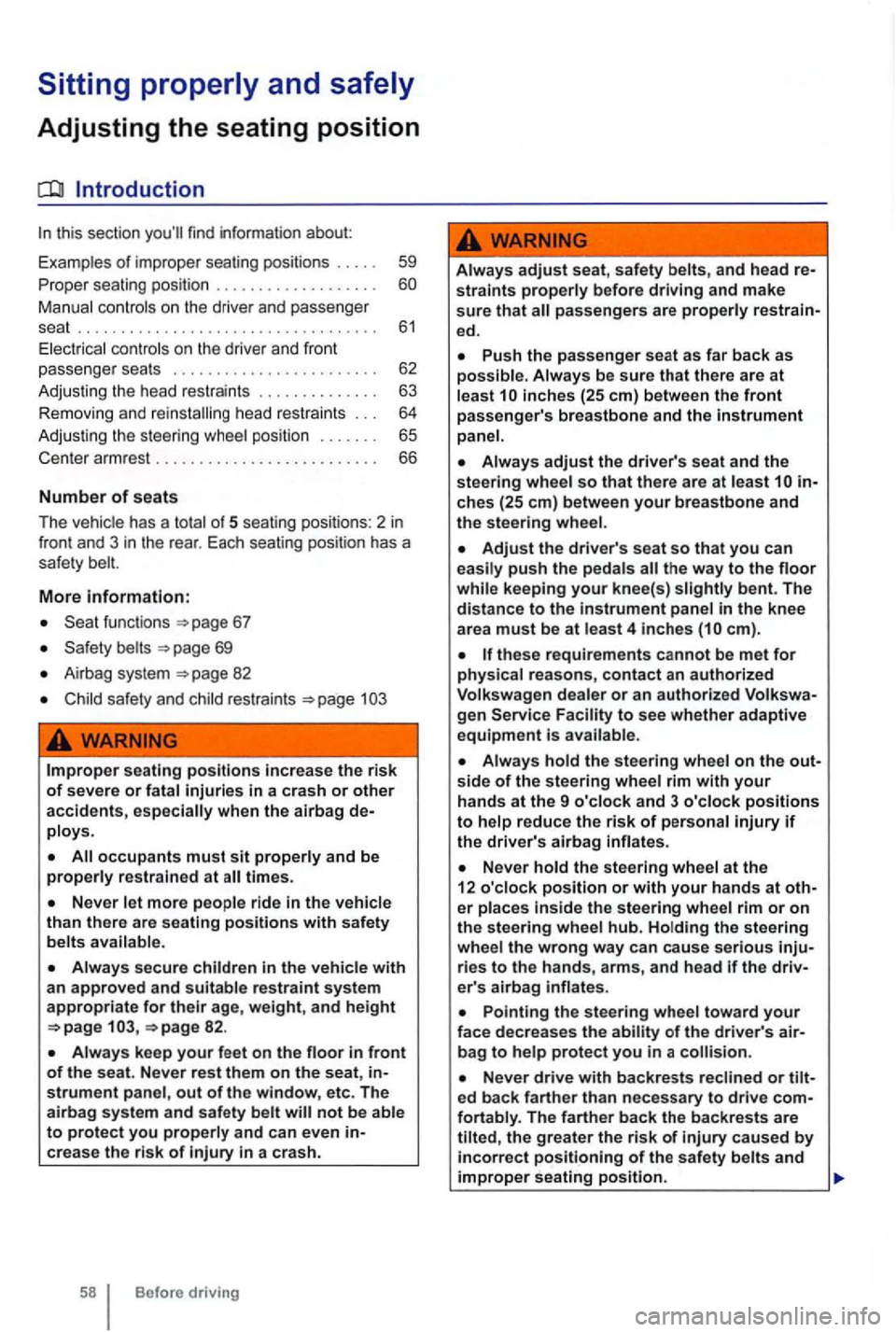
Adjusting the seating position
Introduction
this section find inf ormation about:
Examp les
of improper seat ing pos itions . . . 59
Pr ope r seating position . . . . . . . . . . . . .
Manual contr ols on the driver and passe nger
seat . . . . . . . . . . . . . . . . . . . . . . . . . . . . . . . . . . . 61 Ele ctrica l co ntr ols o n the driver and front
passenger seats . . . . . . . . . . . . . . . . . . . . . . . . 62
Adj ustin g
the head restra ints . . . . . . . . . . . . . 63
R emoving and re in stalling head restraints . . . 64
Adj usting the stee
ring whee l position . . . . . . . 65
Cen te r armrest . . . . . . . . . . . . . . . . . . . . . . . . . . 66
Number of seats
Th e vehicle
has a t otal of 5 seat ing posit ions: 2 in front and 3 in the rea r. Eac h seating pos ition has a
safety belt.
More information:
funct ions 67
page 69
Ai r ba g syste m 82
safety and child restraints
WARNING
Improper seat ing pos itions increase the risk of severe or fatal injuries in a crash or other accidents,
times .
Never
Always secure children in the vehicle with a n approved and suitable restraint system appropriate for their age, weight, and height 82 .
Always keep your feet on the in front of the seat. Never rest them on the seat,
Always adjust seat , safety belts, and head straints properly before driving and make sure that
inches (25 em) betw een the front pa ssenger' s breastbone and the in strument panel.
ches (25 em) between your breastbone and the steering wheel.
Adjust the driver's seat so that you can push the pedals while keeping your knee(s) slightly bent. The
di stance to the instrument panel in the knee
a rea must be at least 4 inche s
these requirements cannot be met for physical reason s, contact an authorized
Volk swagen dealer or an auth orized gen Facility to see whether adaptive equipment is avai la bl e.
Always hold the steering wheel on the side of the steering wheel rim with your hands at the 9 o'clock and 3 o'clock positions to help reduce the risk of personal injury if the driver's airbag inflates .
Never hold the steering whee l a t the
12 o'clock position or with your hands at e r places inside the steering whee l rim or on the steering wheel hub. Holding the steering wheel the wrong way can cause serious rie s to the hand s, arm s, and head if the
Pointing the steer ing whe el t oward your face dec reases the of the driver's bag to h elp protect you in a
Never drive with backrest s reclined or ed back farthe r than necessary to drive
Page 158 of 516
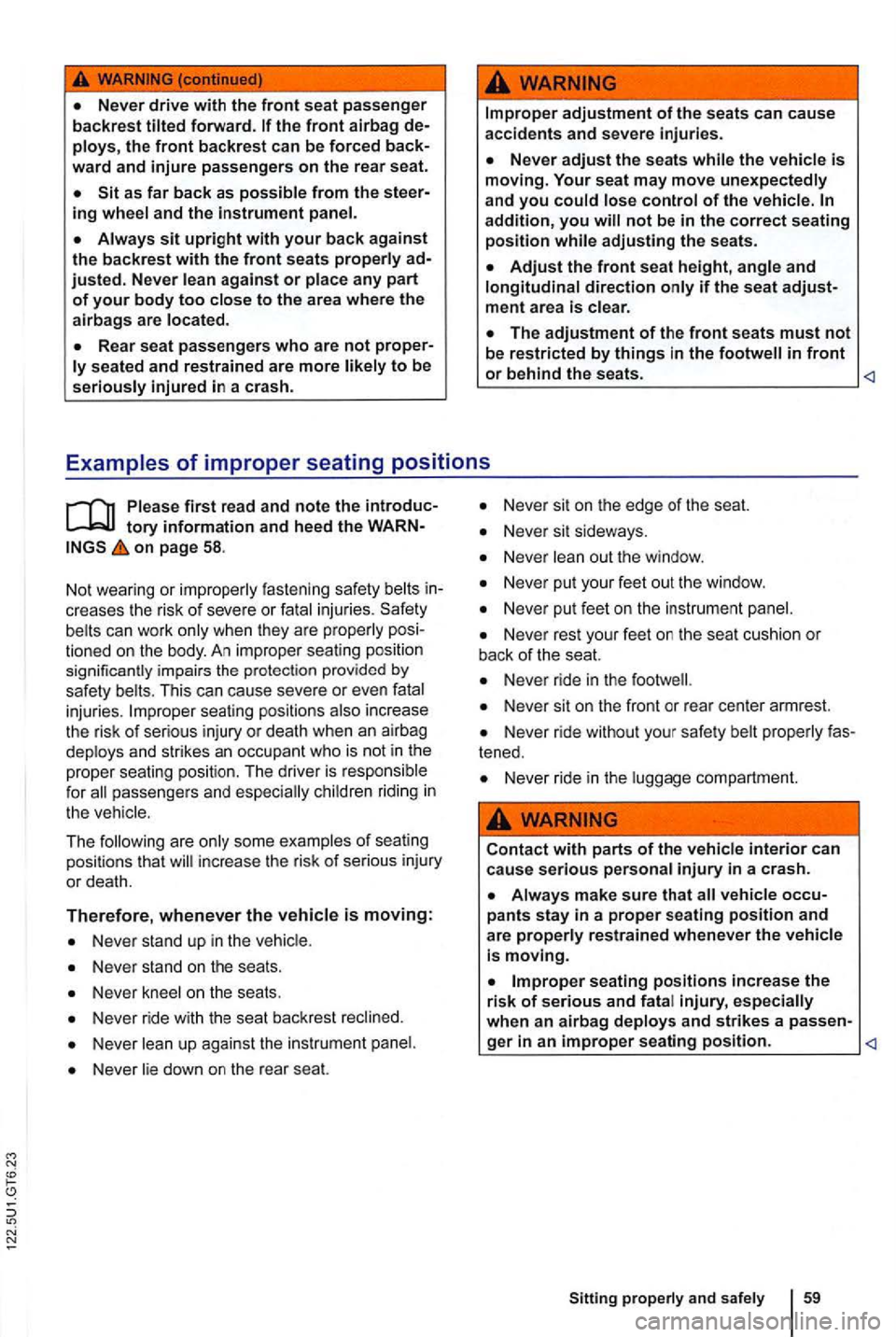
ment area is clear .
on page 58.
No t wea ring or imp rope
rly fastening safety belts creases the risk of seve re o r fatal injuries . Safety
be lts can work only w hen they are p roperly tioned on th e body . An improper seating pos itio n
significan tly impai rs the protection provided by safety belts. Thi s can cause severe or even fatal
inj uries . seating positions also increase
the ris k of ser iou s in jury o r de ath when an airbag
dep loys and strikes an occ upant who is not in the
proper seating position. The driver is respo nsible
f or all passengers
and espec ially c hildren riding in th e vehicle.
T he following are only some examples
of seating
posi tions that will increase the risk of s eri ous injury or death.
Therefore, whenever the vehicle is moving:
Never sit on the edge of the seat.
Never sit sideways.
Contact with parts of the vehicle interior can cause serious personal injury in a crash.
Page 159 of 516
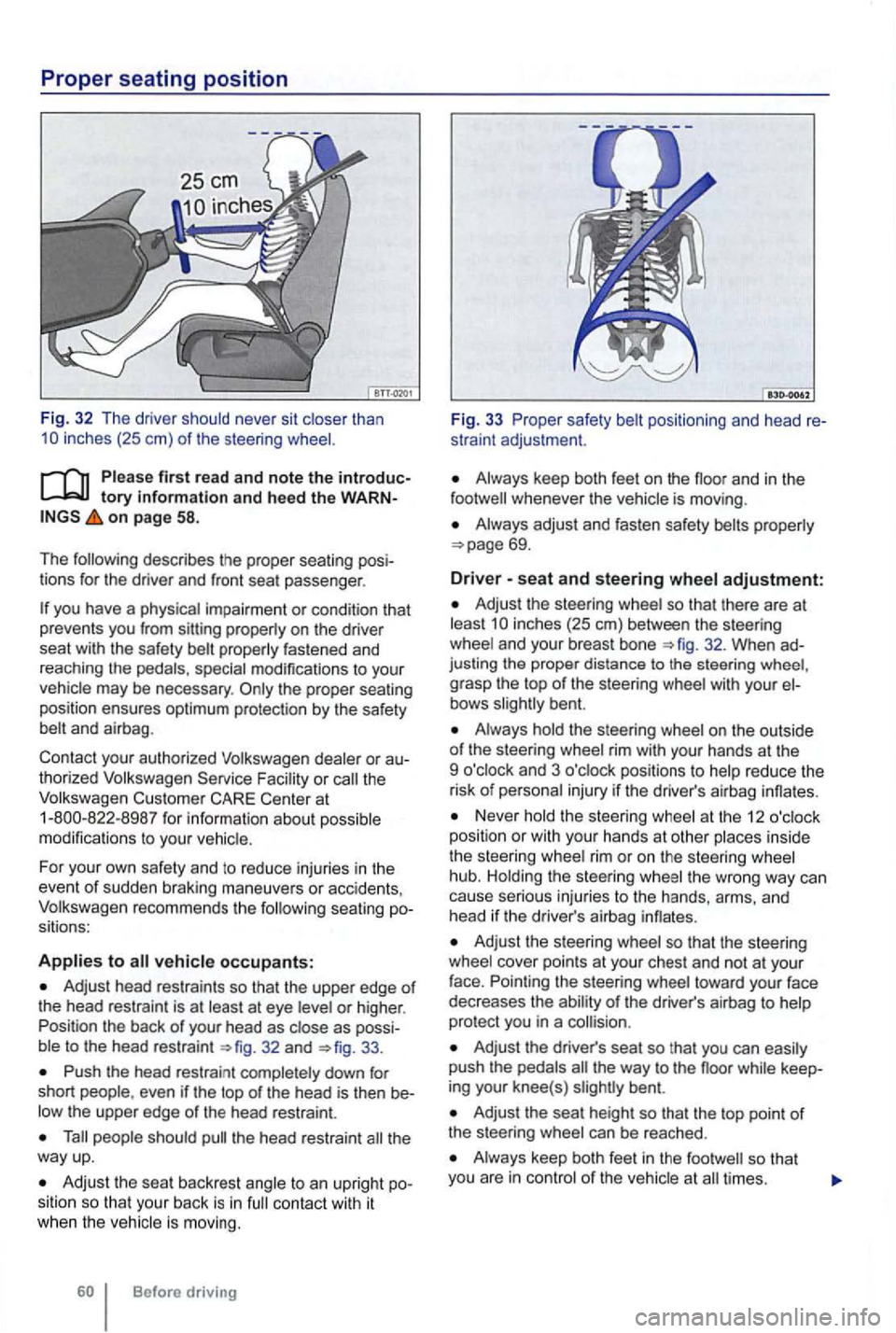
first rea d and note the introductory information and hee d the WARNon page 58.
The following describes the proper seating posi
tions for the driver and front seat passenger .
special modifications to your
vehicle may be necessary .
to
Adjust head restraints so that the upper edge of the head restraint is at least at eye
32 and 33.
Push the head restrai nt completely down for
short even if the top of the head is then be
people should the head restraint the way up.
Adjust the sea t backrest angle to an upright position so that your back is in contact with it when the veh icle is moving.
Before driving
Fig. 33 P roper safety
Always keep both feet on the whenever the vehicle is moving .
Always adjust and fasten safety belts properly
adjustment:
Adjust the steering whe el so that there are at least inches (25 em) between the steeri ng
wheel and your breast bone
grasp the top of the steering wheel with your bent.
Always hold the steering wheel on the outside of the steering wheel rim with your hands at the
9 o'clock and 3 o'clock positions to help reduce the
risk
of personal injury if the driver's airbag innates.
Never hold the steering wheel at the 12
and
head if th e driver's airbag innates.
Adjust the steering wheel so that the steering
wheel cover points at your chest and not at your
face. Pointing the steer ing wheel toward your face
dec reases the ability
of the driver's airbag to help
protec t you in a
Adjust the driver's seat so tha t you can easily push the pedals the way to the noor while keep
ing your knee(s) bent.
Adjust the seat height so that the top point o f
the steering wheel can be reached .
Always keep both feet in the times.
Page 168 of 516
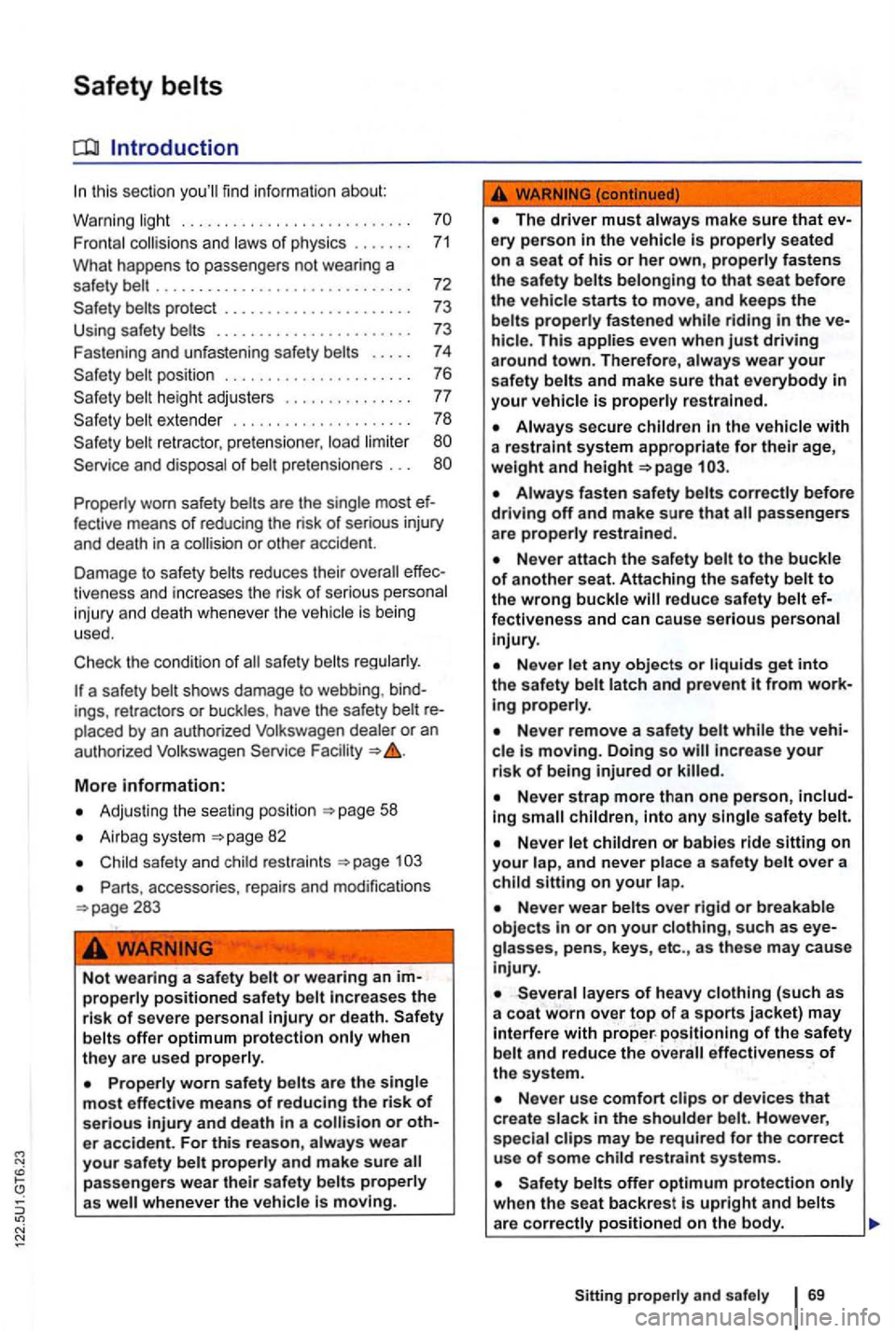
find informati on about:
Fro nt al
Properly worn safety fective means of reducing the risk of serious injury
and death in a or othe r accident.
D amage to sa fety belts reduces their
tiveness and increases the risk of se rious personal
i nj ury and death whenever the vehicle is being
used .
Check the conditi on of
a safe ty belt shows damage to webbing , ings, retracto rs or buckles . have the safety belt
More information:
Adjusting the seating posit io n
Airbag system
Child safety and child restraints 103
Parts , access ories, repai rs and modifications
Properly worn safety belts are the single most effective means of r educing the risk of serious injury and death in a collision or er accident. For this reason , always wear your safety belt properly and make sure all
pa ssengers wear their safety belts properly as well whenever the vehicle
The driver must always make sure that
hicle. Thi s applies even when just driving around town. Therefore, always wear your safety belts and make sure that everybody in your vehicle is properly restrained.
Always secure children
Always fasten safety belts correctly before driving off and make sure that all passengers
are properly re strained .
Never attach the safety belt to the buckle of another seat. Attaching the safety belt to the wrong buckle will reduce safety belt fectiveness and can cause serious personal injury.
cle is moving. Doing so will
small children, into any single safety belt.
Never wear belts over rigid or breakable objects in or on your clothing, such as glasses, pens, keys, etc., as these may cause injury.
layers of heavy clothing (such as
a coat worn over top of a sports jacket) may with proper. positioning of the safety belt and reduce the overall effectiveness of the system .
Never use comfort clips or devices that create slack in the shoulder belt. However,
s pecial clips may be required for the correc t
u se of some child res traint systems.
Page 169 of 516
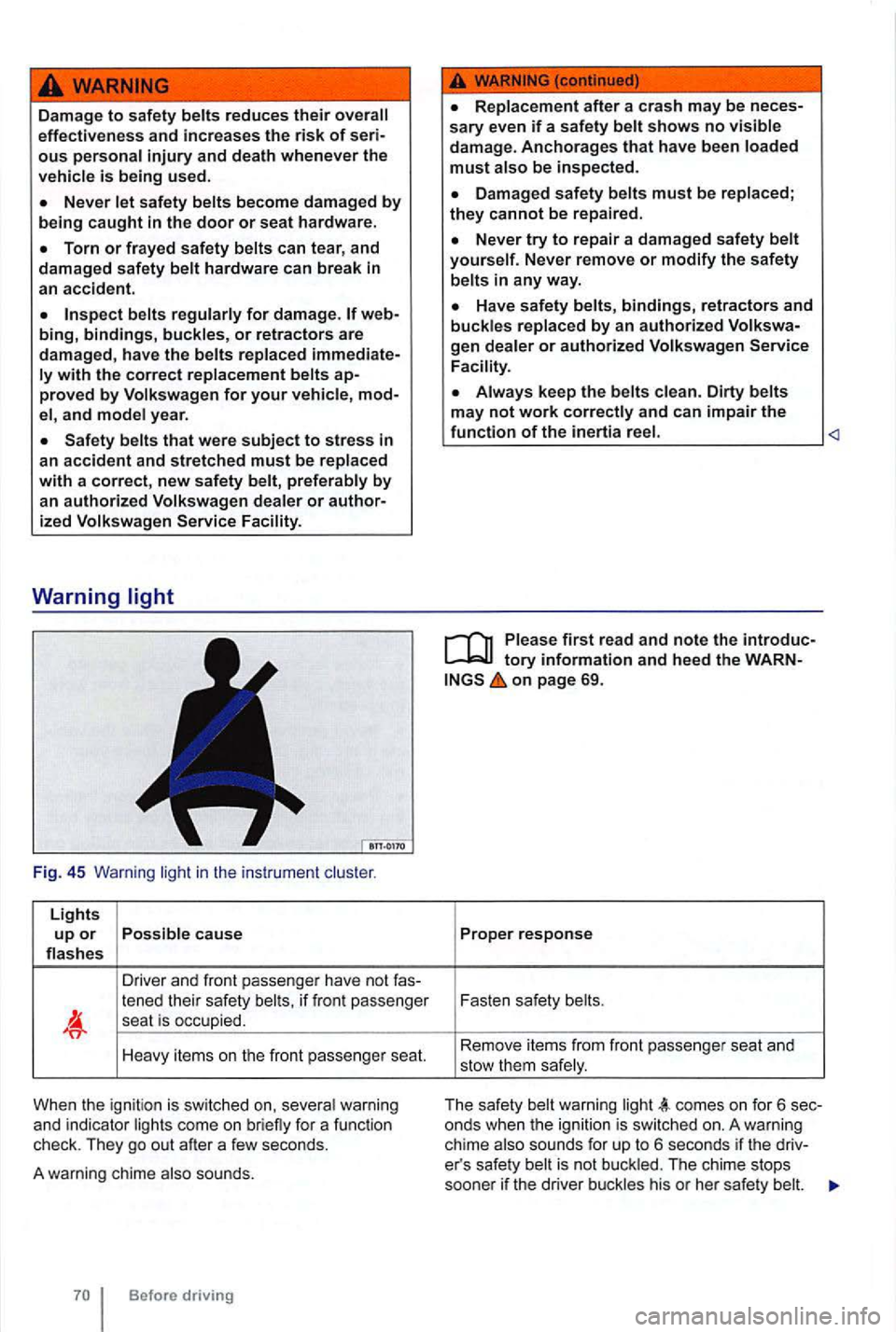
Damage to safety belts re duces their effective ne ss and increa ses the risk of serious personal injury and death whenever the
v ehicle is being used.
Torn or frayed safety belts can te ar, and
damag ed safety belt hardware can break
web
bing, bindings, buc kles, or retractors are damaged , hav e the belts replaced immediate
ly with the correct replacement belts proved by Volkswagen for your vehicle, model , and model yea r.
Fig . 45 Warning light in the instrume nt
Lights up or Possible caus e flas hes
Driver and front p asse nge r have not
tened their safety belts, if fr o nt passenger sea t is occup ied.
Heavy items on the front passe nge r seat.
Whe n the ign itio n is switched on, seve ra l warni ng
and indica tor lights come on brie fly for a func tion
check. They go out after a few seconds.
A warning chime also sounds.
Replacement after a crash may be neces
s ary even if a sa fety belt shows no visible damag e. Anchorages that have been loaded must also be inspect ed .
D amaged safety belts must be replaced ; they cannot be repaired .
Never try to repair a dam ag ed s afety belt yourself. Never remove or modify the safety
belts in any way.
Have safety belts, bindings, retractors and buckles replaced by an authorized
Always keep the belts clean . Dirty belts
may not work
tory information and heed the WARNon page 69.
Proper response
Fasten safety belts .
Re move it e m s f
rom fr ont passe nger seat and
stow them safe ly .
T
he safety belt wa rnin g light comes on f or 6 sec
onds when the ignition is sw itched on. A warning
ch ime also sounds for up to 6 seco nds if the driver's safe ty belt is not bu ckl ed . Th e c hime stops
soone r if the driver buckles his or her safe ty be lt.
Page 172 of 516
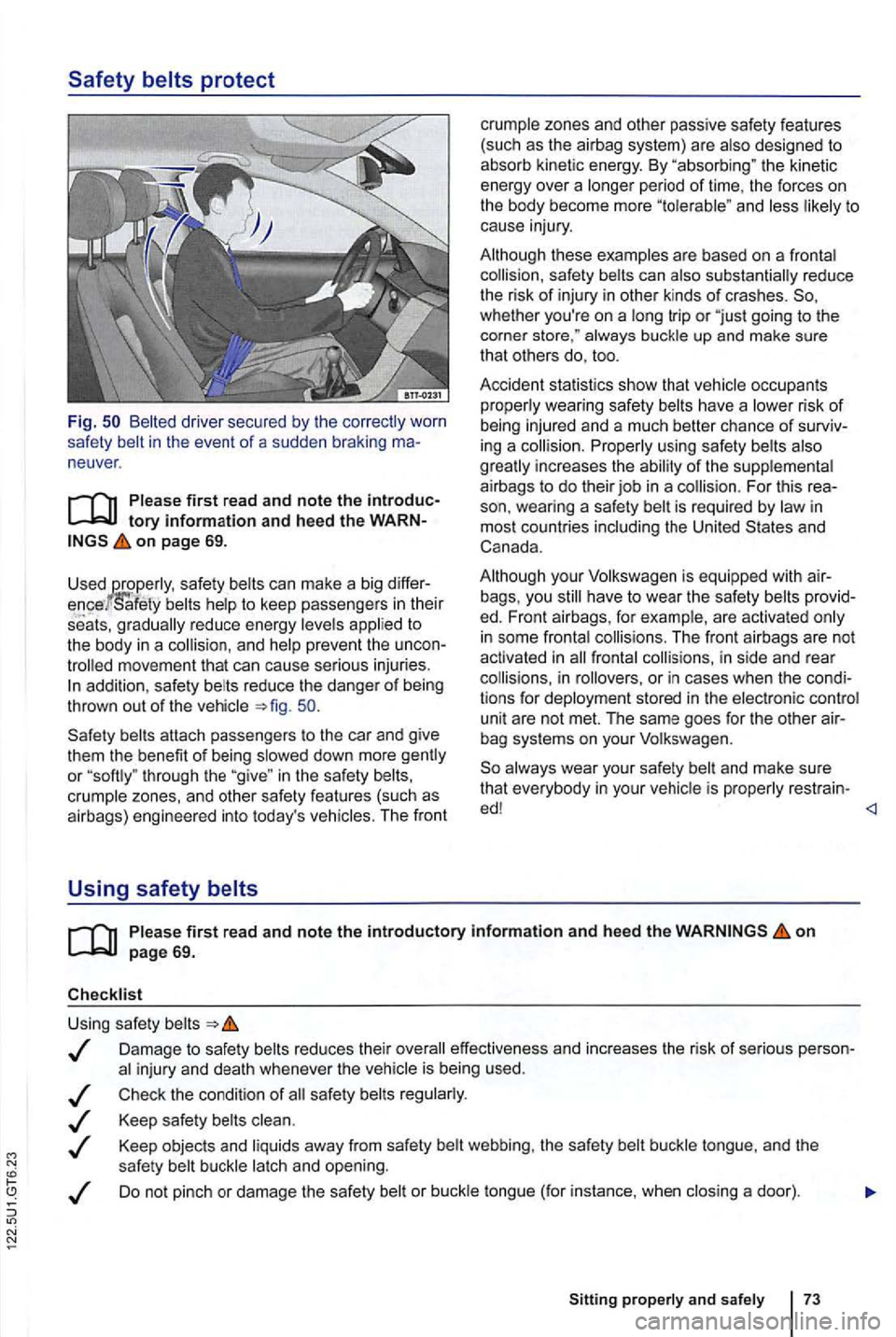
Safety belts protect
Fig. Belted driver secured by the
neuver .
on page 69.
Used safe ty can make a big
to
the body in a co llision , and help prevent the
addition , safe ty reduce the danger of being
thrown out of the vehicle
or through the in the safety crumple zones, and other safety features (such as
airbags) engineered into today's The front
Using safety belts
crumple zones and other passive safety features
(such as the airbag system) are also designed to
absorb kinetic energy. By "absorbing " the kinetic
energy over a longe r pe riod
of time, the forces on
the body become more to
cause injury.
Although these examples are based on a fronta l
collision , safety
whether you're on a long trip or "just going to the
corner always buckle up and make sure
that others do, too.
Accident statist ics show that vehicle occupants
p roperly wearing safety
also
g reatly increases the ability of the supp lementa l
airbags to do thei r job in a collision. For this is required by in
most countries including the United
your Volkswagen is equipped with have to wear the safety
bag systems on your Volkswagen.
always wear your safety is properly restra in -
ed!
o n
Damage to safety reduces their overall effectiveness and increases the risk of serious injury and death whenever the
Check the condition of
webbing , the safety buckle tongue, and the
safety buckle latch and opening.
Do not pinch or damage the safety
Page 173 of 516
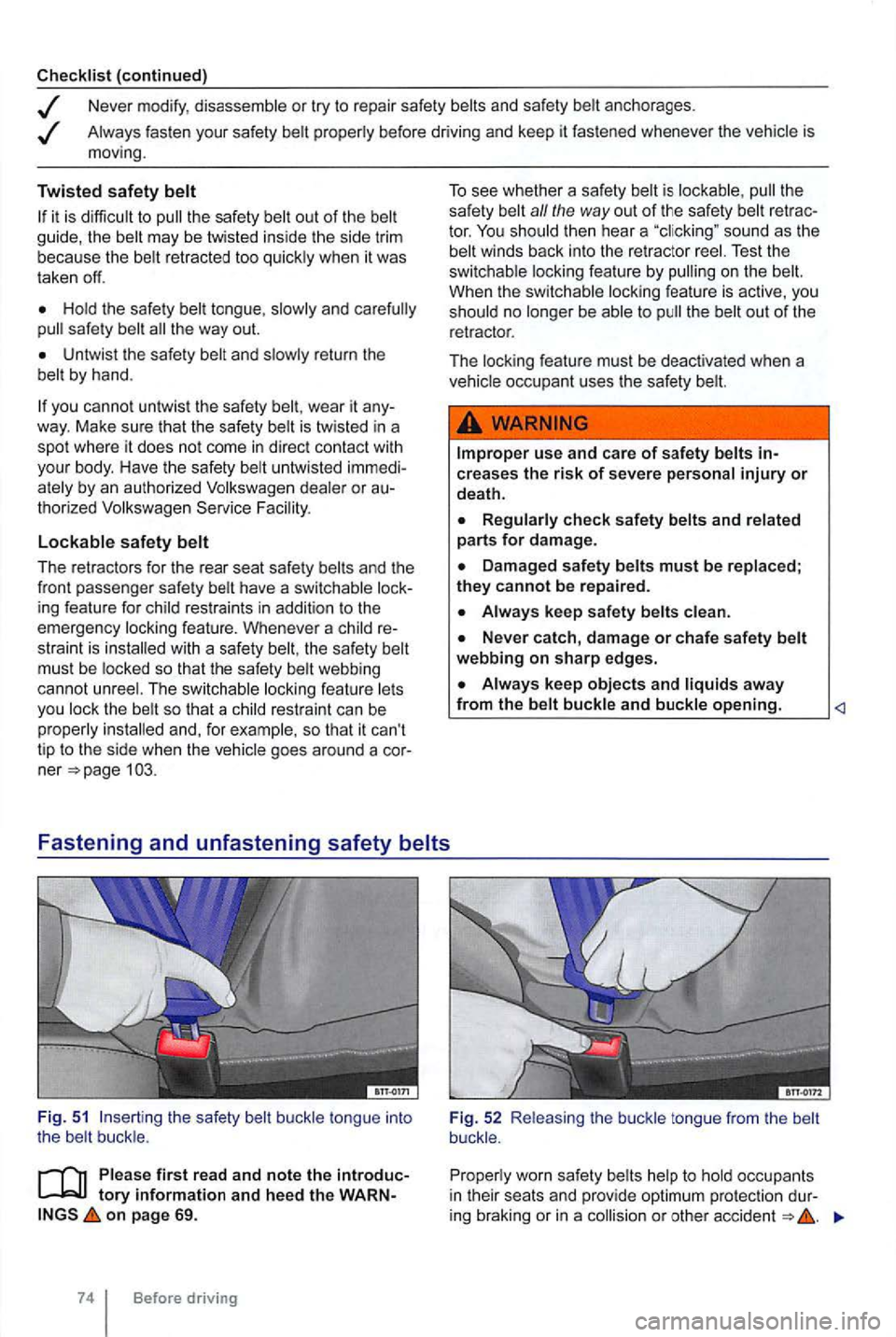
Checklist (continued)
Never modify , disassemble or try to repair safety belts and safety belt anchorages .
Always fasten your safety belt prope rly befo re d rivi ng and keep it fastened whenever the vehicle is
mov ing.
Twisted safety belt
may be twis ted inside th e side tr im
because the belt ret rac ted too quickly when it was tak en off.
Hold the safety safety belt the way out.
Untwist the safety belt and slowly return the
belt by hand.
you cannot untwist the safety belt, wear it way. Make sure th at the saf e ty is twisted in a
spot where it does not come in direct contact with you r body. Have th e safety belt untw isted
t horized Volkswagen F ac ility.
Lockable safety b elt
T he retractors for the rear seat safety belts and the
front passenger safety
The switchable lock ing featu re lets
you lock the so th at a c hil d restraint can be
proper ly a nd, for examp le, so that it can't
tip to the side when the
ne r
Fig. 51 th e safety belt buckl e tongu e int o the belt buckle .
Please first r ea d and note the introduc
on pag e 69 .
Before driving T
o see whether a safety belt is lockab le ,
the
safety bel t a// the way out of the safety belt tor. Test the
switchable locking feature by
u se and care of safety belts
R egularly check safety belt s and relat ed parts fo r d amage.
Always kee p sa fety b elts clea n.
Never c atch, d amage or chafe sa fety b elt
webbing on sharp edges.
Always kee p objects and liquids away from the belt buckle and buckle opening.
Fig . 52 R eleas ing the buckle tongue from the belt
buck le .
Proper ly worn safety belts help to hold occupan ts
i n their seats and provide optim um protect ion dur-
i
ng braking or in a